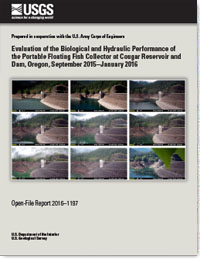Evaluation of the biological and hydraulic performance of the portable floating fish collector at Cougar Reservoir and Dam, Oregon, September 2015–January 2016
Links
- Document: Report (9.5 MB pdf)
- Download citation as: RIS | Dublin Core
Abstract
The biological and hydraulic performance of a portable floating fish collector (PFFC) located in the cul-de-sac of Cougar Dam and Reservoir, Oregon, was evaluated during 2015–16. The PFFC, first commissioned in May 2014, was modified during winter 2014–15 to address several deficiencies identified during operation and testing in 2014. These modifications included raising the water inflow structures to reduce the depth and volume of inflow to improve the internal hydraulic profiles, and moving the anchors so the PFFC could be positioned closer to the existing reservoir outlet, a water temperature control tower. The PFFC was positioned about 18 meters (m) upstream of the intake of the water temperature control tower and faced into the prevailing water current. Like several floating surface collectors operating in the Pacific Northwest at the time, the PFFC used pumps to draw water and fish over an inclined plane, past dewatering screens, and into a collection area. The portable and experimental nature of the PFFC required a smaller size, shallower entrance (about 2.5-m deep), and smaller inflow rate (72 cubic feet per second [ft3/s] inflow during the Low treatment, 122 ft3/s during the High treatment) than other collectors in the region.
The collection of the target species, juvenile Chinook salmon (Oncorhynchus tshawytscha), during 2015–16 was an order of magnitude larger than in 2014. Subyearling-age Chinook salmon comprised most of the catch (2,616 subyearling compared to 258 yearling) and was greatest during the spring during the High inflow treatment. Bycatch consisted predominantly of cyprinids and centrarchids. Trap mortality (fish found dead in the trap) of juvenile Chinook salmon, at 9.2 percent of the subyearlings and 5.0 percent of yearlings, was about 30 percent of the level in 2014. Fish mortality from handling the live catch was about 1 percent.
Data from fish tagged with passive integrated transponder (PIT) tags and those with acoustic+PIT tags released near the head of the reservoir indicated the catch rates of the PFFC were low. Eight of the 1,497 PIT-tagged fish and 5 of the 534 acoustic+PIT-tagged fish were collected by the PFFC. Fish collection efficiencies—the number collected by the PFFC out of the number detected at the head of the forebay (FCEFB) or in the cul-de-sac (FCECDS)—were 0.002 and 0.003 during the Low treatment and 0.008 and 0.009 during the High treatment. The low FCEs were attributed to the following factors:
- Few acoustic+PIT-tagged fish were detected within 10 m of the PFFC entrance,
- Most fish were detected between the stern of the PFFC and the entrance to the tower,
- Fish depths commonly were several times greater than the PFFC entrance depth, and
- Surface water temperatures were warm.
The data suggest that the shallow entrance and low inflow rate reduced fish guidance near the PFFC entrance and the hydraulic characteristics resulting from the outflow plumes (and perhaps water entering the temperature control tower) attracted fish to that area. Catch of juvenile Chinook salmon likely would increase if the collector entrance were deepened, the inflow rate were increased, and measures were taken to constrain fish presence to the area upstream of the trap entrance.
Suggested Citation
Beeman, J.W., Evans, S.D., Haner, P.V., Hansel, H.C., Hansen, A.C., Hansen, G.S., Hatton, T.W., Kofoot, E.E., and Sprando, J.M., 2016, Evaluation of the biological and hydraulic performance of the portable floating fish collector at Cougar Reservoir and Dam, Oregon, September 2015–January 2016: U.S. Geological Survey Open-File Report 2016–1197, 98 p., https://doi.org/10.3133/ofr20161197.
ISSN: 2331-1258 (online)
Study Area
Table of Contents
- Acknowledgments
- Abstract
- Introduction
- Methods
- Results
- Discussion
- References Cited
- Appendixes A–I
| Publication type | Report |
|---|---|
| Publication Subtype | USGS Numbered Series |
| Title | Evaluation of the biological and hydraulic performance of the portable floating fish collector at Cougar Reservoir and Dam, Oregon, September 2015–January 2016 |
| Series title | Open-File Report |
| Series number | 2016-1197 |
| DOI | 10.3133/ofr20161197 |
| Publication Date | November 28, 2016 |
| Year Published | 2016 |
| Language | English |
| Publisher | U.S. Geological Survey |
| Publisher location | Reston, VA |
| Contributing office(s) | Western Fisheries Research Center |
| Description | x, 98 p. |
| Country | United States |
| State | Oregon |
| Other Geospatial | Cougar Reservoir and Dam |
| Online Only (Y/N) | Y |


